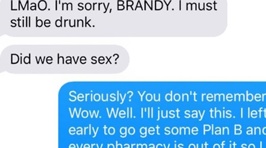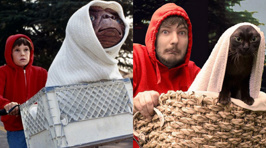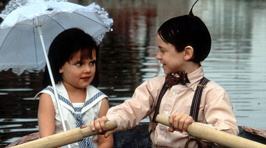Was Harry Potter Just a Disturbed Patient in an Insane Asylum Called "Hogwarts?"
Loading...
-
1/11
![1. In Harry Potter and the Sorcerer's Stone, young Harry becomes obsessed with a mirror at his new "school". Night after night, he sits in front of it, imagining his perfect parents. Dumbledore warns him that the mirror has driven individuals insane. He explains:
"It shows us nothing more or less than the deepest, most desperate desire of our hearts. You, who have never known your family, see them standing around you. [...] Men have wasted away before it, entranced by what they have seen, or been driven mad, not knowing if what it shows is real or even possible." Spending all of your time in fantasy detaches you from the reality of the real world. The theory argues that this is exactly what ends up happening to Harry for the rest of the books.](https://www.zmonline.com/media/14010063/001.jpg?rmode=max&v=1d060d2d49445b0&height=635&width=635&quality=100&scale=both) 1/11 1. In Harry Potter and the Sorcerer's Stone, young Harry becomes obsessed with a mirror at his new "school". Night after night, he sits in front of it, imagining his perfect parents. Dumbledore warns him that the mirror has driven individuals insane. He explains: "It shows us nothing more or less than the deepest, most desperate desire of our hearts. You, who have never known your family, see them standing around you. [...] Men have wasted away before it, entranced by what they have seen, or been driven mad, not knowing if what it shows is real or even possible." Spending all of your time in fantasy detaches you from the reality of the real world. The theory argues that this is exactly what ends up happening to Harry for the rest of the books.
1/11 1. In Harry Potter and the Sorcerer's Stone, young Harry becomes obsessed with a mirror at his new "school". Night after night, he sits in front of it, imagining his perfect parents. Dumbledore warns him that the mirror has driven individuals insane. He explains: "It shows us nothing more or less than the deepest, most desperate desire of our hearts. You, who have never known your family, see them standing around you. [...] Men have wasted away before it, entranced by what they have seen, or been driven mad, not knowing if what it shows is real or even possible." Spending all of your time in fantasy detaches you from the reality of the real world. The theory argues that this is exactly what ends up happening to Harry for the rest of the books. -
2/11
 2/11 2. Hogwarts resembles a dangerous mental prison. The school is filled with random and unexplainable dangers. There are moving staircases, talking paintings and deadly monsters like three-headed dogs roaming forbidden corridors. There are also hidden dungeons, in which people seem to become possessed, as in the case of Ginny Weasley who starts writing on walls in blood. Magnus argues that in Hogwarts, these bizarre happenings have, in fact, "ordinary" magical explanations.
2/11 2. Hogwarts resembles a dangerous mental prison. The school is filled with random and unexplainable dangers. There are moving staircases, talking paintings and deadly monsters like three-headed dogs roaming forbidden corridors. There are also hidden dungeons, in which people seem to become possessed, as in the case of Ginny Weasley who starts writing on walls in blood. Magnus argues that in Hogwarts, these bizarre happenings have, in fact, "ordinary" magical explanations. -
3/11
 3/11 3. Sirius Black is clearly insane. Even if he is innocent of the charged crimes, his stint at the Dementor-guarded prison would be enough to make anyone crazy. Speaking of the terrible creatures, Remus Lupin warns: "They infest the darkest, filthiest places, they glory in decay and despair, they drain peace, hope, and happiness out of the air around them... Get too near a Dementor and every good feeling, every happy memory will be sucked out of you. If it can, the Dementor will feed on you long enough to reduce you to something like itself... soulless and evil. You will be left with nothing but the worst experiences of your life." Dementors feed on human happiness and cause depression, sometimes reducing their victims into a permanent vegetative state. Essentially, they lead individuals to complete psychological collapse, making a person "brain-dead." No wonder Black and Bellatrix Lestrange go off the rails.
3/11 3. Sirius Black is clearly insane. Even if he is innocent of the charged crimes, his stint at the Dementor-guarded prison would be enough to make anyone crazy. Speaking of the terrible creatures, Remus Lupin warns: "They infest the darkest, filthiest places, they glory in decay and despair, they drain peace, hope, and happiness out of the air around them... Get too near a Dementor and every good feeling, every happy memory will be sucked out of you. If it can, the Dementor will feed on you long enough to reduce you to something like itself... soulless and evil. You will be left with nothing but the worst experiences of your life." Dementors feed on human happiness and cause depression, sometimes reducing their victims into a permanent vegetative state. Essentially, they lead individuals to complete psychological collapse, making a person "brain-dead." No wonder Black and Bellatrix Lestrange go off the rails. -
4/11
 4/11 4. The Goblet of Fire mirrors the experience of mentally ill children in an institution. The contest puts students up against each other in openly life-threatening scenarios. This is very similar to situations in mental institutions in which disturbed children are regularly violent towards one another.
4/11 4. The Goblet of Fire mirrors the experience of mentally ill children in an institution. The contest puts students up against each other in openly life-threatening scenarios. This is very similar to situations in mental institutions in which disturbed children are regularly violent towards one another. -
5/11
 5/11 5. Harry is closely associated with Remus Lupin, who is a werewolf. This creature is obsessed with the moon, which is a symbol for insanity.
5/11 5. Harry is closely associated with Remus Lupin, who is a werewolf. This creature is obsessed with the moon, which is a symbol for insanity. -
6/11
 6/11 6. Harry murders Cedric Diggory. Cedric is the ultimate image of the popular, successful boy Harry always wanted to be. When we learn that he is mercilessly killed by "Voldemort," we forget to question the legitimacy of this actually happening. This theory claims that instead, it is Harry who kills Cedric. This is because the Dark Lord is his alter ego and a projection of his hate. This is backed up by the fact that Harry is the only one who witnesses the evil deed and nobody else believes him. When numerous people question his honesty, it becomes an unspoken metaphor for the fact that everyone secretly knows he did it. Finally, the entire scenario takes place in a maze where the biggest threat is becoming possessed or going insane. Alternatively, the theory stipulates that if the entire scenario was entirely imagined by Harry, then the murder of an innocent, normal boy can also be seen as a metaphor for Harry losing his mind and his final chance at normality.
6/11 6. Harry murders Cedric Diggory. Cedric is the ultimate image of the popular, successful boy Harry always wanted to be. When we learn that he is mercilessly killed by "Voldemort," we forget to question the legitimacy of this actually happening. This theory claims that instead, it is Harry who kills Cedric. This is because the Dark Lord is his alter ego and a projection of his hate. This is backed up by the fact that Harry is the only one who witnesses the evil deed and nobody else believes him. When numerous people question his honesty, it becomes an unspoken metaphor for the fact that everyone secretly knows he did it. Finally, the entire scenario takes place in a maze where the biggest threat is becoming possessed or going insane. Alternatively, the theory stipulates that if the entire scenario was entirely imagined by Harry, then the murder of an innocent, normal boy can also be seen as a metaphor for Harry losing his mind and his final chance at normality. -
7/11
 7/11 7. Harry returns to civilian life only to be quickly taken away again. At the beginning of Order and the Phoenix, Harry attacks and traumatizes Dudley. He cannot lead a normal life without descending into a violent abyss so needs to be taken away to Hogwarts again. Harry interprets the incident as a Dementor attack, which normal people cannot see. In efforts to decide what to do with the 'violent' boy, he is brought in front of a panel which determines whether he is too dangerous for Hogwarts (a low security institution) or whether he should be sent to Azkaban (a harsh mental asylum).
7/11 7. Harry returns to civilian life only to be quickly taken away again. At the beginning of Order and the Phoenix, Harry attacks and traumatizes Dudley. He cannot lead a normal life without descending into a violent abyss so needs to be taken away to Hogwarts again. Harry interprets the incident as a Dementor attack, which normal people cannot see. In efforts to decide what to do with the 'violent' boy, he is brought in front of a panel which determines whether he is too dangerous for Hogwarts (a low security institution) or whether he should be sent to Azkaban (a harsh mental asylum). -
8/11
 8/11 8. Harry's friends are "a bit odd". Luna Lovegood's name itself implies lunacy and she is often referred to as being a bit strange. Coincidentally, she is also the only other person who can see Harry's "delusions," such as Thestrals. Speaking about the avid Quibbler reader, Hermione says: "Apparently she'll only believe in things as long as there's no proof at all." Even Luna agrees that she's not like the other kids at all: "I think they think I'm a bit odd, you know. Some people call me 'Loony' Lovegood, actually." Similarly, Neville Longbottom comes from a history of mental illness. His parents are patients, having been driven insane by Bellatrix's torture. Living in the shadow of their painful existence, that in itself undoubtedly makes him psychologically scarred too.
8/11 8. Harry's friends are "a bit odd". Luna Lovegood's name itself implies lunacy and she is often referred to as being a bit strange. Coincidentally, she is also the only other person who can see Harry's "delusions," such as Thestrals. Speaking about the avid Quibbler reader, Hermione says: "Apparently she'll only believe in things as long as there's no proof at all." Even Luna agrees that she's not like the other kids at all: "I think they think I'm a bit odd, you know. Some people call me 'Loony' Lovegood, actually." Similarly, Neville Longbottom comes from a history of mental illness. His parents are patients, having been driven insane by Bellatrix's torture. Living in the shadow of their painful existence, that in itself undoubtedly makes him psychologically scarred too. -
9/11
 9/11 9. Harry suffers from a split personality disorder. There are many parallels and similarities between him and "Tom Riddle" (the young "Voldemort"): Both are orphans, They have the same wand, They both speak parseltongue, They possess the same diary, They both consider Hogwarts to be their home, Both descend from great wizards, They both ask Slughorn about Horcruxes. Harry also keeps having visions of his other self and shares thoughts with another "being." His mind is plagued with "Voldemort" - at first it is merely a haunting whisper but it soon begins to dominate him entirely. Additionally, following this theory, Snape's attempts to strength Harry's mind through Occlumency simply reflects a doctor trying to cure a patient of hearing voices in his head. The goal of the blocking technique is to make one's mind "blank and empty," which also somewhat echoes psychiatric treatments used to calm paranoid patients in real-life.
9/11 9. Harry suffers from a split personality disorder. There are many parallels and similarities between him and "Tom Riddle" (the young "Voldemort"): Both are orphans, They have the same wand, They both speak parseltongue, They possess the same diary, They both consider Hogwarts to be their home, Both descend from great wizards, They both ask Slughorn about Horcruxes. Harry also keeps having visions of his other self and shares thoughts with another "being." His mind is plagued with "Voldemort" - at first it is merely a haunting whisper but it soon begins to dominate him entirely. Additionally, following this theory, Snape's attempts to strength Harry's mind through Occlumency simply reflects a doctor trying to cure a patient of hearing voices in his head. The goal of the blocking technique is to make one's mind "blank and empty," which also somewhat echoes psychiatric treatments used to calm paranoid patients in real-life. -
10/11
 10/11 10. Harry knows all along he is being taken to an insane asylum. If we follow the theory that the Boy Who Lived is in fact Tom Riddle, then this could make sense. In the Half-Blood Prince, when Dumbledore comes to take Tom/Harry from the orphanage, he says he is going to take him to a special school for children just like him. The boy's first response is to accuse Dumbledore of being a doctor, stating "I'm not mad." He then implies that he knows that Hogwarts is an insane asylum and that he refuses to go.
10/11 10. Harry knows all along he is being taken to an insane asylum. If we follow the theory that the Boy Who Lived is in fact Tom Riddle, then this could make sense. In the Half-Blood Prince, when Dumbledore comes to take Tom/Harry from the orphanage, he says he is going to take him to a special school for children just like him. The boy's first response is to accuse Dumbledore of being a doctor, stating "I'm not mad." He then implies that he knows that Hogwarts is an insane asylum and that he refuses to go. -
11/11
 11/11 11. Harry's meeting with Dumbledore at Kings Cross. When the two meet in this imagined vision, the following dialogue occurs: "Tell me one last thing," said Harry. "Is this real? Or has this been happening inside my head?" Dumbledore beamed at him, and his voice sounded loud and strong in Harry's ears even though the bright mist was descending again, obscuring his figure. "Of course it is happening inside your head, Harry, but why on earth should that mean that it is not real?"
11/11 11. Harry's meeting with Dumbledore at Kings Cross. When the two meet in this imagined vision, the following dialogue occurs: "Tell me one last thing," said Harry. "Is this real? Or has this been happening inside my head?" Dumbledore beamed at him, and his voice sounded loud and strong in Harry's ears even though the bright mist was descending again, obscuring his figure. "Of course it is happening inside your head, Harry, but why on earth should that mean that it is not real?" -
More Galleries
-
 This guy completely transformed a hoarder's house and the results are so satisfying
This guy completely transformed a hoarder's house and the results are so satisfying
-
 Girl gives out fake number to guys; the guy who owns the number is a massive troll
Girl gives out fake number to guys; the guy who owns the number is a massive troll
-
 Guy recreates famous movies with his cat and they are purrfect
Guy recreates famous movies with his cat and they are purrfect
-
 Alfalfa from 'The Little Rascals' is all grown up and smashing life
Alfalfa from 'The Little Rascals' is all grown up and smashing life
-
 What happens when a couple asks the internet to photoshop an object out of their pic
What happens when a couple asks the internet to photoshop an object out of their pic
-
 Reddit users admit the things we all do when drinking but refuse to acknowledge
Reddit users admit the things we all do when drinking but refuse to acknowledge
-
Naturally, with any book, TV series or movie, there will always be theories explaining why it's not exactly what you thought it was...
One Harry Potter fan called Magnus came up with a theory that "Hogwarts" is perhaps not a Wizardly School after all. According to the theory, mental illness is featured almost everywhere in the series.











